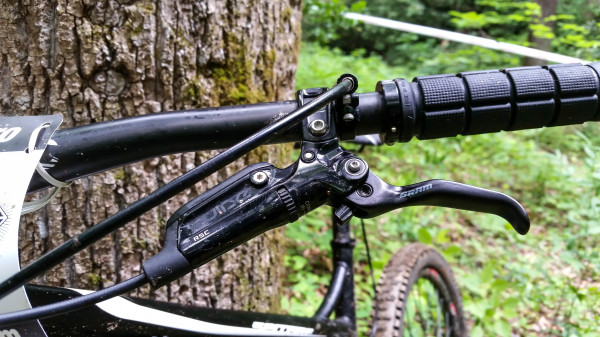With their latest MTB stoppers in short supply, I was fortunate to get my hands on a set of the new SRAM Guide RSC disc brakes just in time for the very challenging Pisgah Enduro.
Not often would I consider swapping my favorite stoppers, Formula R0’s, for something different the week before an event that incorporates roughly 55 miles spread over 7 stages with around 13,000 feet of technical and rough climbing and descending. But the Guides were easy to set up and felt good right out of the box. Still, I did pack my Formulas in my tool bag juuuust in case a 20 mile pre-ride left me in doubt. Needless to say, the Guides stayed on.”
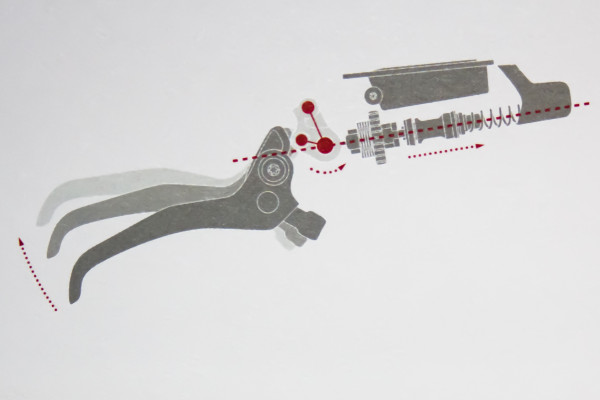
The SRAM Guides come in 3 variations: R, RS, and RSC. R = Reach Adjust, S = Swinglink, and C = Contact (pad) Adjust. The lever’s all new reservoir and bladder shape are said to offer a more failsafe management of fluid, reduce the chance for air bubbles and improve back-pressure relief to improve braking consistency. The Swinglink pivot is what SRAM says will set their brakes apart from the competition. In addition to producing a more positive pad engagement, once in contact with the disc, the Swinglink is said to give the brakes’ modulation a more linear delivery. This should give the brakes less of an on/off feel and more of an on/controlled feel without sacrificing power.
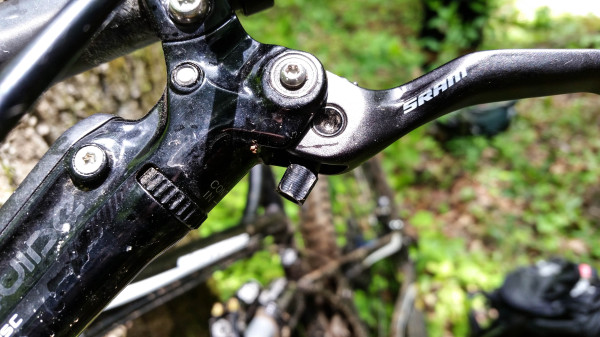
To really fine tune the brakes, SRAM incorporated “Lever Pivot Bearings” to keep the nicely designed “one finger” lever blade pulling smooth and feeling solid. They also came up with a much improved way of adjusting both lever position and pad contact. I’ve played with several brakes’ reach and contact adjustments, but the Guide’s are one of if not the easiest to fine tune. The reach adjust was pretty easy to work, but the contact adjustment was not only easy, but had a wide range to work within. Even as many as five clicks of adjustment made only the slightest change letting a rider really get it where they want it.
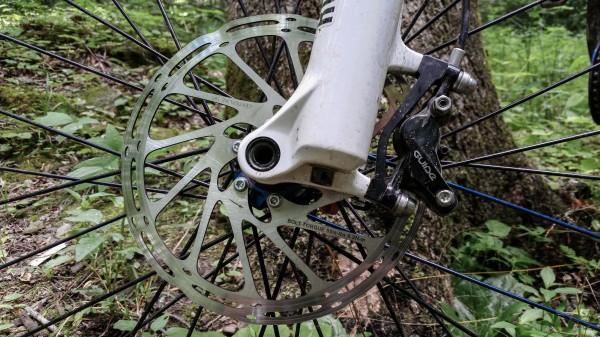
The SRAM Guides came packaged with their new Centerline rotors that are designed to even out the center of friction to reduce vibration. Vibration that we all know as incredibly irritating noise. I ran a 180mm up front and a 160mm out back. My initial ride in dry conditions did not produce any vibration or noise, and in wet conditions, the Centerline Rotors seem to have reduced brake noise significantly. SRAM still uses the same hose fittings they’ve used for years so cutting the hose and setting them back up was as easy as ever. First thing I noticed was the brakes were not near as big as they appeared in pictures. Because they use a smaller lever blade similar to Shimano’s, the entire assembly looked huge in pictures, but actually are not any bigger than Shimano’s XTR Trail brakes. Initial lever feel on the workstand had a similar “hard hit” as the Shimanos but with a softer feel at the end of the lever’s initial stroke. Not spongy, but progressive…… so I hoped.
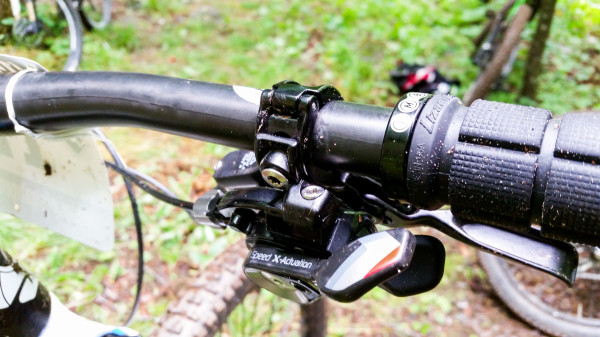
The initial feel of the brakes was good once bedded in on my local trails, but these are “trail” brakes, not XC brakes so the jury was still out until I got to Pisgah’s now not so secret proving grounds. Thanks to our friend Hak, we got to shuttle to what was to be some very difficult-to-get-to timed segments for our pre-ride. In general they worked great, but once we hit the 2 biggies, Kitsuma and Heartbreak, they really came alive. We were not riding the course at race pace so there was a ton of hard braking. Though I never experienced any brake fade, the 160 rear was noticeably inadequate for a person weighing in around 185lb hitting speeds in the mid-30’s with a really grabby tire on a long technical descent. The (now blue) 160mm rotors were not up to that job, but because I brought a standard 180mm Avid HSX rotor along as back-up, all was good in the world come race day.
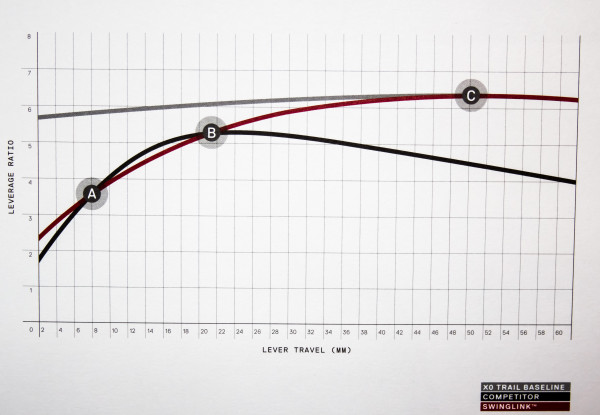
While putting the brakes through their paces, what I really noticed and liked about them was the solid engagement followed by a very controllable ability to “feather” them without locking up the brakes unless I wanted to. There were sections that I could easily control my speed at the last second without skidding. The brakes did not feel mushy – there was plenty of effortless power on tap when you ask for it. I would describe it as more of a sweet spot that you have complete control of until you tell your trigger finger to fire. Once lit up, the Guide RSC’s put down gobs of speed robbing power, but with good control. Predictability is key here, and the Guide RSC brakes get top marks for this.
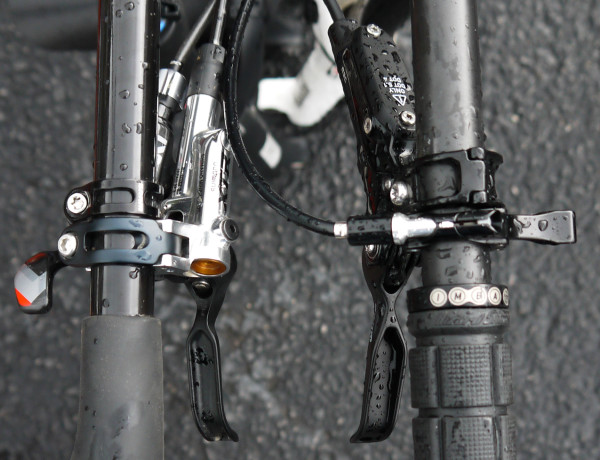
So the big question is: How do these stand up against Shimano’s “holy grail” XTR Trail brakes? I had spent time on the XTR Trails prior, and got to do a quick side by side comparison between them and the Guides, but because of a bad storm system interrupting my ride day, I wasn’t able to get them out on the trail for back to back runs. Initial lever feel of the Guides is similar to the XTR Trails, as is the size of the lever blade. The Shimano levers have a slightly easier pull than the Guides, but just barely. I am one of the few who thinks that the Shimanos are a little too on/off feeling, but I agree with the masses they are just plain fantastic performers. Preference for brake feel is as subjective as choosing wheel sizes, so I won’t/can’t say which feels better. I give the SRAM Guides props on having a great tooless lever and contact adjustment. Though not a deal breaker since the contact adjustment should be “set and forget”, but things happen at times to where we need to dial something mid ride, and I like that about the Guides.
Look for a long term review down the road to see how SRAM’s new Guides really stand the test of time.
